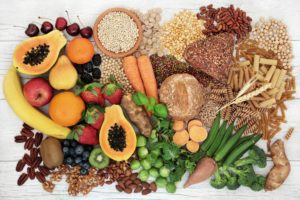 Fiber is the stuff that helps you stay regular, right? Partly. In the last couple of years, the research on fiber’s benefits has been growing substantially, showing it is an instrumental part of overall health and wellness. And the more that is learned, the more important it is to make sure you’re getting about 25–35 grams per day.
Fiber is the stuff that helps you stay regular, right? Partly. In the last couple of years, the research on fiber’s benefits has been growing substantially, showing it is an instrumental part of overall health and wellness. And the more that is learned, the more important it is to make sure you’re getting about 25–35 grams per day.
Along with improving digestion and promoting regular, comfortable bowel movements, dietary fiber has the ability to:
- Reduce cholesterol (particularly “bad” LDL)
- Lower blood sugar (may help prevent insulin resistance and type-2 diabetes)
- Prevent constipation
- Improve heart health
- Might reduce the risk for colon cancer
- Might help to control weight
- Improve gut health
- Keep you feeling full
Advertisement
“Fiber” is somewhat of a blanket term used to describe several compounds, much like the word “vitamins.” Some different types of fibers are beta-glucans, pectin, guar gum, psyllium, and chitosan. These compounds go undigested in the stomach, instead serving as a source of food gut bacteria.
There are two main types of fiber that are typically outlined: soluble and insoluble. General thought insists that soluble fiber, which is typically found in oats and legumes, helps lower cholesterol and regulate blood sugar. Insoluble fiber, found in wheat bran, fruit, and vegetables, was what was believed to keep people regular. But it turns out things aren’t back and white. Some fibers do both, while others don’t seem to have any influence on cholesterol.
So, what does that mean for you? It means not only trying to get 25–35g per day, but using a variety of sources to get there. Mixing up fiber-rich food, and eating it throughout the day might be the best way to get the most benefit from your fiber. Whole grains, oats, nuts and seeds, as well as fruits and vegetables (with skin when possible), are the best options. Some high-fiber foods to reach for include:
- 100% wheat bran cereal (can be sprinkled on yogurt with nuts and berries for a high-fiber breakfast or snack)
- Oats
- Navy beans
- Split peas
- Artichoke hearts
- Lentils
- Prunes
- Guava
- Berries
- Pears
No matter what your tastes are, there are high-fiber foods that will cater. Decide to include more of these, and you’ll likely notice you’re less hungry and your health is improving.
